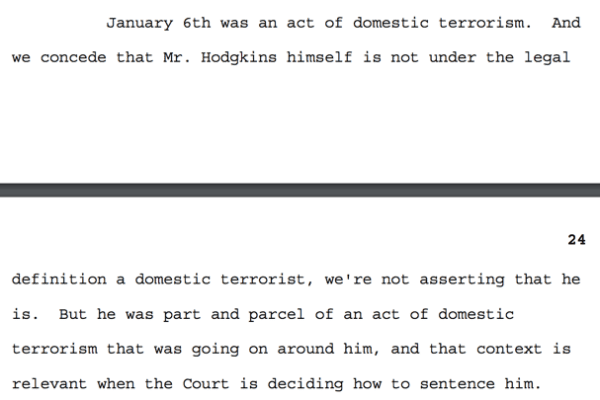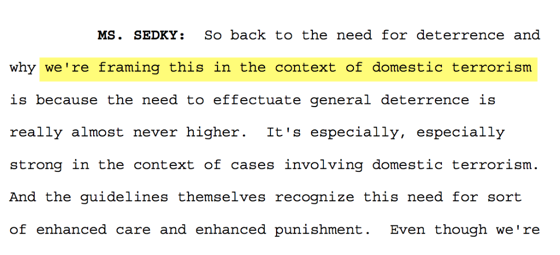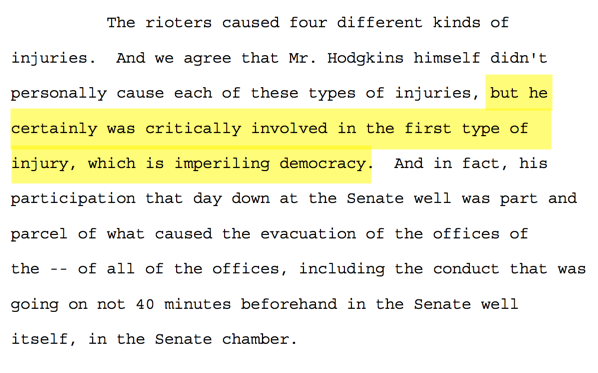In Radical Affront to Civil Liberties, the Government Is Branding Non-Violent Jan. 6 Defendants “Terrorists”
Michael Tracey, Substack, July 23, 2021
This week, the first felony sentence was handed down in relation to what’s popularly called the “insurrection” of January 6, 2021. Though he only pleaded guilty to a single count of “obstruction of an official proceeding,” defendant Paul Hodgkins — whose criminal act entailed milling around the Senate chamber for approximately 15 minutes — nonetheless found himself branded a “terrorist” in open court by the US Government. Per prosecutors’ own admission, Hodgkins committed no acts of physical violence, and wielded no weapons. He was also never formally accused of any “terrorist” offenses, at least in a way that the Government would actually have to prove beyond a reasonable doubt. Regardless, prosecutors have now introduced a theory in which it’s alleged that Hodgkins and other non-violent Jan. 6 defendants were operating within a supposed “context” of terrorism — and it’s this “context” that they’re citing to argue for more severe punishment.
Ultimately, Hodgkins was sentenced to eight months in prison — a long time to be confined to a cage, of course, but perhaps not the length of incarceration one would typically associate with a deadly act of “terrorism.” So there’s something incongruous about this newly concocted terrorism-designation approach. Here is how Special Assistant US Attorney Mona Sedky rolled out her new “terrorism” theory at Hodgkins’ sentencing hearing on July 19:

Read that carefully. The Government admits that Hodgkins’ actual conduct does not meet any legally cognizable definition of “terrorism,” but nonetheless argues that Hodgkins was “part” of a domestic terrorism event — i.e., partook in the commission of a terrorist attack — and is therefore effectively a terrorist! They’re more or less saying, “We can’t meet the legal burden to actually prove that he’s guilty of terrorism, so we’re just going to kind of vaguely assert as much in this slippery, unfalsifiable way.” Expanding the applicability of “terrorism” in such a manner is self-evidently menacing to civil liberties — it’s essentially the Government claiming the ability to accuse you of terrorism without ever having to clear the due process hurdles of legally establishing your guilt. Sedky added:

“Framing”? “Context”? What? When did “domestic terrorism” become some kind of interpretive literary principle? These are weasel-words, the vagueness of which enable the Government to level one of the most extraordinary accusations it could possibly level against a citizen — that he is a terrorist — without having to subject that designation to meaningfully adversarial scrutiny. It’s all the more galling, because again, Hodgkins was not even alleged to have committed any physical violence. “The Government nonetheless recognizes that Hodgkins did not personally engage in or espouse violence or property destruction,” wrote Sedky in a sentencing memo. But in the “context” of Jan. 6 — the hyper-charged, seismically hyperbolic political climate that these proceedings are taking place within — the “symbolism” of the affair has taken primacy.
Judge Randolph D. Moss of the DC District Court (a Democratic appointee, if anyone’s keeping score) was particularly aggrieved that Hodgkins had carried a “TRUMP 2020” flag when he meandered onto the Senate floor, as opposed to an American flag. Moss opined that this choice of flags was evidence of Hodgkins “declaring his loyalty to a single individual over the nation.” That’s quite a feat of mind-reading — who knew that sporting a presidential candidate’s campaign paraphernalia presumptively indicates “disloyalty” to the US? But the Judge confessed to being extremely fixated on “the symbolism” of Hodgkins’ act, which allegedly “captured the threat to democracy that we all witnessed that day.” {snip}
It gets creepier. While the Government conceded that Hodgkins engaged in no violent conduct, wielded no weapons, and caused no physical injury, they turned around and invented a new type of “injury” he allegedly inflicted in order to demand a harsher prison sentence. This “injury” conceived by the Government appears to be a form of metaphysical injury, or perhaps some bizarre political injury? Sedky again:

{snip}
Prosecutors’ wild journey of “injury invention” didn’t stop there. Sedky went on to posit that Hodgkins was culpable for unspecified “emotional injury” — a thematic continuation of the months-long pity-party that Jan. 6 has allowed politicians and journalists to throw for themselves. {snip}
“He proudly posed for selfies and texted those to his friends,” Sedky gravely added. Has there ever been a supposed terrorist insurrection in which “selfies” played such an integral role? At this point, the very concept of “terrorism” might have to be fundamentally re-defined to emphasize the apparent centrality of the existential “selfie” threat. “You walked among the desks on the Senate floor and took selfies,” Judge Moss later reprimanded Hodgkins. {snip}
Over and over it was claimed by Sedky that while Hodgkins “did not participate in the physical violence or the destruction, he surely participated in the grave danger to our democracy.” Or in other words, Hodgkins was deserving of a 18-month prison sentence in the Government’s eyes because of the symbolic affront he committed. And that’s why the nonstop deluge of melodramatically overblown rhetoric around Jan. 6 — “insurrection,” “attempted coup,” “domestic terror,” “overturning the election,” etc. — has been such a crucial ingredient in federal prosecutors’ drive to obtain maximal punishment for the alleged offenders. They are specifically citing these symbolism-based grievances to demand harsh incarceration terms even for defendants whom they admit engaged in no physical violence. The “emotional injury” they’re invoking is supposedly the country’s emotional injury, or something, and Hodgkins must pay the therapy bill.
In the sentencing memo submitted by the Government, Sedky affirms “the need to deter others is especially strong in cases involving domestic terrorism, which the breach of the Capitol certainly was.” But where does that “certainty” derive from, exactly? As yet, none of the Jan. 6 defendants have been formally accused of any “terrorism”-related offenses, and there are plenty on the books for prosecutors to choose from if they so desire. The Government instead has been relegated to vaguely insinuating the existence of a terrorism “context,” which must be a challenging task given that so many defendants have been charged with the supposedly “terroristic” crime of “Parading, Demonstrating, or Picketing in any of the Capitol Buildings.” What’s next, terrorist jaywalking?
{snip}
This prosecutorial tactic demonstrates that the Government has reserved the right to explicitly brand all participants in the Jan. 6 episode “terrorists,” regardless of the severity of the actual wrongdoing they are accused of committing {snip}
{snip}















